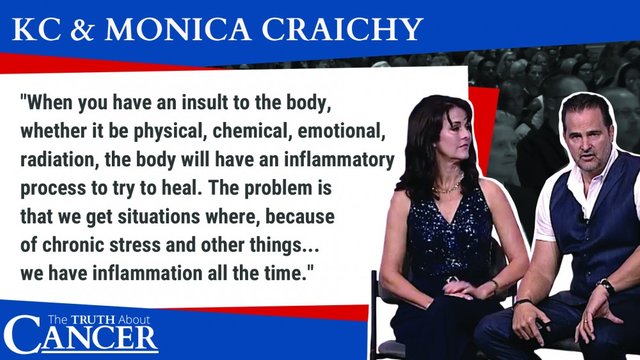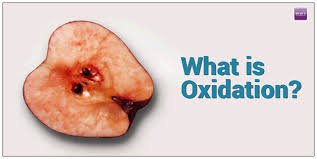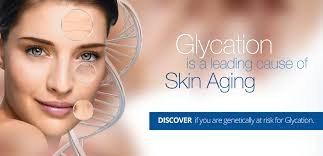https://www.youtube.com/watch?time_continue=10&v=rZtRnpEVRm8

Video Transcript: The 4 Root Causes of Cancer – KC & Monica Craichy
Ty Bollinger: What is the truth about the root causes of cancer? Did you know that there are basically four underlying factors of the root of almost every cancer? Can you guess what they are? In this video excerpt from last year’s Truth About Cancer Live in Orlando…
Charlene Bollinger: … our good friends KC and Monica Craichy, founders of LivingFuel, will teach you what these 4 factors are and how natural foods can be even more effective than over the counter drugs. Get out your pens, paper, iPads, and whatever else you might use, and take some notes. You’re going to learn a lot from this. So listen carefully.
KC Craichy: So, we’re here today on a quest for truth. The word of God says, “You shall know the truth and the truth shall make you free.” See it’s not the truth that makes you free, it’s you knowing it. So today we’re going to talk about four underlying factors that are basically at the root of just about every cancer. There are exceptions.
Monica Craichy: So, there is inflammation, oxidation, glycation, and angiogenesis. KC, real fast, what’s inflammation?
KC Craichy: You know when you twist your ankle it will start to swell and inflame, you put ice on it and so on, but it’s a process. When you have an insult to the body, whether it be physical, chemical, emotional, radiation, the body will have an inflammatory process to try to heal. The problem is that we get situations where, because of chronic stress and other things we’ve got going on, we have inflammation all the time because the body is always trying to heal something or thinks it’s trying to heal something and you have a state of chronic inflammation, like PSA in a prostate is an inflammatory marker.
Monica Craichy: And what’s oxidation?

KC Craichy: Oxidation, essentially, I’m trying to be layman here, if you cut an apple and put it on the table and come back in an hour, it’s brown, right? So essentially rust on the human body, when oxygen hits the molecules, it essentially damages them. And the body has an innate system, an antioxidant network, to deal with regular stressors, or regular oxidation. But the body, when it’s overwhelmed, like we are today with lack of sleep and stress and terrible nutrition and worry and all the things that we do, the body requires substantial additional antioxidants to stop that process of hyper aging and rusting of the body.
Monica Craichy: Okay, glycation.

KC Craichy: Glycation, similar to oxidation except for it involves sugar and proteins. So, when you caramelize onions, you basically take sugar and you stick it to the outside of the onion molecule or the onions. So that’s what happens to your proteins. So, if your glycated proteins— basically became unusable, you have sugar without an enzyme wrapped in a protein making it unusable.
And as you become older you can actually have up to a third of your proteins glycated. And you see a lot of times when the skin is cross linked, or you see unhealthy looking skin, that essentially is AGEing. A-G-E, advance glycation end products. That’s what this is. So, it’s a hyper aging. I actually wrote about this several years ago, five years ago, and said in five years it’s going to be as well known as oxidation; and still nobody knows about this. So, it’s a process that’s going on – one of the processes going on.
Monica Craichy: Angiogenesis.

KC Craichy: Angiogenesis. Again, let’s use the ankle as an example. If you twist your ankle, your body will open up new capillaries and vessels and actually grow more vessels to bring more blood supply to that area in the healing process. It happens when you have a wound, the body will put new blood vessels to bring blood and healing into that area.
It’s a fantastic process, but it also is the process by which cancer is a problem, because many people have cancer cells all their life and it’s never a problem, the immune system handles it, deal with it, no problem. But if a cancer cell can get an angiogenic blood supply, literally the body will feed a supply of blood to a cancer cell and it will grow, and there’s nothing you can do about it, essentially, at that point.
So, angiogenesis, also when you have body fat. Body fat, basically every pound of body fat has an additional one to two miles of angiogenic vessel to hold that fat and to supply that area.
So, this is a very powerful process, but the thing we’re trying to tell you here, and this is the important part, I’ll try to stay light on the science, but when you go to inflammation, the types of foods that we love to eat, you see the types of foods that actually can counteract inflammation.
Inflammation is a huge area in pharmacology. They want new anti-inflammatory drugs all the time. If you recall, Vioxx killed 50,000 people before they took it off the market, 50,000 people. Anti-inflammatories can be very dangerous. We know Tylenol, acetaminophen, is a very dangerous thing, but people give it to their kids all the time.
So, anti-inflammatories are big business, but essentially there are a lot of foods and supplements with the same power if not greater than some of these things that we’re taking that are dangerous.
Monica Craichy: Well, in the next couple slides we’re showing, I mean, you might want to take a picture of it with your phone, but you know there are foods that combat oxidation; there’s foods that combat glycation; there are foods that combat angiogenesis also so…
KC Craichy: So, they regulate and quench these processes. So, if you can stop the process of these four processes, theoretically you can stop any disease. It does not just apply to cancer. So, if you can stop these processes, you can stop a disease theoretically.
So interestingly, in the case even of angiogenesis, it’s been shown that many of the foods on this list, other antioxidants also, anti-inflammatories also, many of these foods on this list outscore every angiogenic drug. There are foods that outscore every angiogenic drug. That’s a huge area in pharmacology right now finding angiogenics.

This is a little example. If you look at the purple line there… that’s conventional cancer therapy. So, we’re talking about three years of life after intervention. And you know, in medicine, we do the craziest things, or they do let’s say, because I’m not going to take credit for this, but they take success as being a certain lifespan after treatment. No; success is long life shall you live, not just a certain number of years. But in this particular case, cancer treatment is the purple and when they add anti-angiogenic drugs, you see you double the lifespan. Double just by blocking the angiogenic process.
Hi! I am a robot. I just upvoted you! I found similar content that readers might be interested in:
https://thetruthaboutcancer.com/root-causes-of-cancer/
Downvoting a post can decrease pending rewards and make it less visible. Common reasons:
Submit